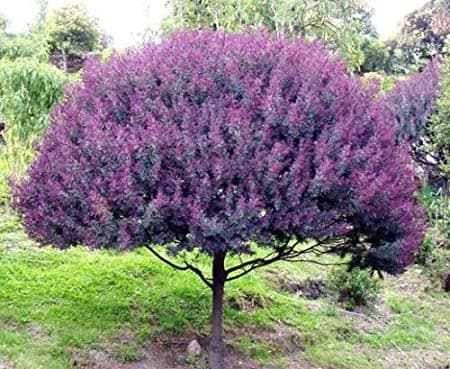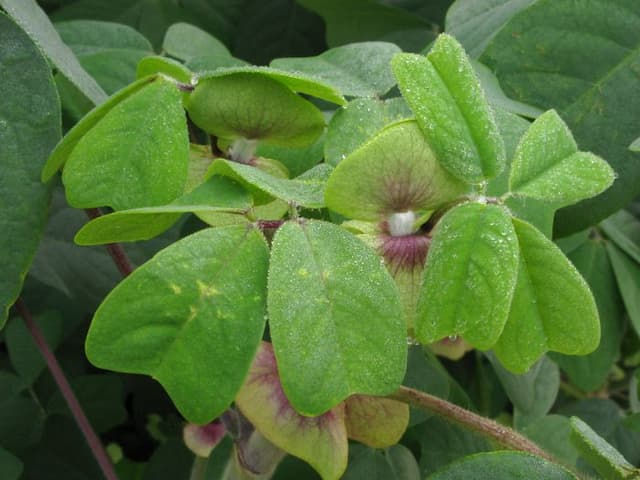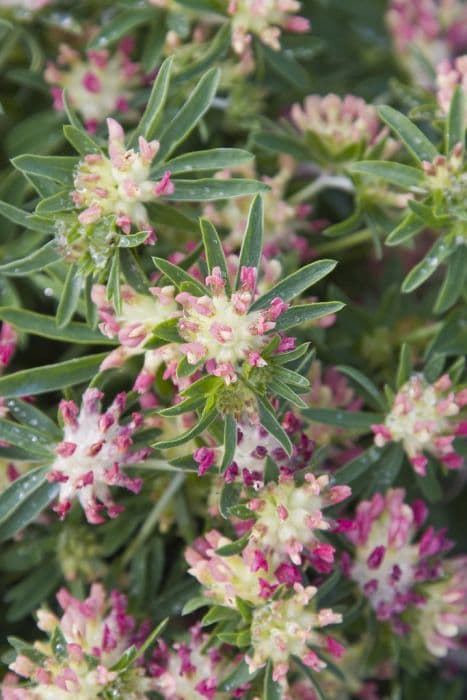Ovens Wattle Acacia pravissima

ABOUT
The common name for Acacia pravissima is the Ovens Wattle. This plant boasts a unique and eye-catching appearance, characterized by its evergreen foliage that remains vibrant throughout the year. The leaves are not typical; instead, the plant has modified structures called phyllodes, which are flattened leaf stems that function as leaves. These phyllodes are a grayish-green hue and have a distinctive triangular or wedge shape, adding a textural aspect to the plant's overall look. One of the most striking features of the Ovens Wattle is its abundant flowering. During the blooming season, which generally occurs in late winter to early spring, the plant is adorned with clusters of small, bright yellow flowers. These flowers possess a soft, fluffy appearance due to the stamens which are prominent, while the petals are almost non-existent. The blossoms are arranged in a globular shape, and together they create a spectacular display that can add a splash of color to the surroundings. The bark of the Ovens Wattle complements its foliage, with a smooth to slightly textured surface that can vary in color from a light gray to a more brownish hue, providing a contrasting backdrop for its bright flowers and silvery-green phyllodes. While the overall form of the plant is not discussed in terms of specific dimensions, it is noted for its bushy and spreading habit, which makes it an attractive choice for gardeners. This dense growth contributes to its use as a screening plant or as part of a landscaped garden where its ornamental qualities can be fully appreciated. The Ovens Wattle's eye-catching form, striking flowers, and lush foliage make it a distinctive feature in any setting where it is planted.
About this plant
 Names
NamesFamily
Fabaceae
Synonyms
Ovens Wattle, Tumut Wattle
Common names
Acacia pravissima, Racosperma pravissimum.
 Toxicity
ToxicityTo humans
Ovens Wattle is not widely known to be toxic to humans. However, like many plants, it may cause irritation or allergic reactions in some individuals. If ingested in large quantities, it could potentially cause stomach upset or discomfort, but there isn't a well-documented case of poisoning from this specific species. Always exercise caution and avoid ingesting parts of plants that are not confirmed to be edible.
To pets
Ovens Wattle is not commonly listed as a toxic plant to pets either. However, pets, much like humans, can have varying sensitivities, and it's possible for individual animals to experience gastrointestinal upset or an allergic reaction if they consume parts of the plant. As a general rule, it is best to prevent pets from ingesting this or any unknown plants, to avoid potential negative reactions.
 Characteristics
CharacteristicsLife cycle
Perennials
Foliage type
Evergreen
Color of leaves
Green
Flower color
Yellow
Height
10-20 feet (3-6 meters)
Spread
6-12 feet (2-4 meters)
Plant type
Shrubs
Hardiness zones
8
Native area
Australia
Benefits
 General Benefits
General Benefits- Landscape aesthetics: Acacia pravissima, commonly known as Ovens Wattle, offers unique visual interest with its triangular foliage and weeping habit, making it an attractive choice for gardens and parks.
- Habitat support: Ovens Wattle provides food and shelter for a variety of bird species, as well as insects like bees which are attracted to its flowers for their nectar and pollen.
- Erosion control: The root system of Acacia pravissima helps stabilize soil, making it useful for controlling erosion on slopes and in areas susceptible to land degradation.
- Drought tolerance: Ovens Wattle is highly drought-resistant once established, making it suitable for dry and arid climates as well as water-wise landscaping.
- Fast growth: The plant grows relatively quickly, which can be beneficial for creating screens or hedges in a short amount of time.
- Nitrogen fixer: As a member of the legume family, Ovens Wattle enriches the soil by fixing nitrogen, thus improving soil fertility and helping other plants to grow.
- Low maintenance: It requires minimal care once established, making it a convenient option for both public landscapes and private gardens.
- Seasonal interest: The yellow, fragrant flowers bloom in early spring, providing a display of color and adding seasonal interest to the landscape.
- Suitable for reclamation: Acacia pravissima can be used in land reclamation projects to help restore natural ecosystems.
- Adaptable: It can tolerate a range of soil types, including poor soils, which makes it a versatile species for various planting locations.
- Wildlife food source: The seed pods of Ovens Wattle are a food source for various species of wildlife.
 Medical Properties
Medical Properties- This plant is not used for medical purposes.
 Air-purifying Qualities
Air-purifying QualitiesThis plant is not specifically known for air purifying qualities.
 Other Uses
Other Uses- Ovensia or Acacia pravissima can be used in the production of honey; bees are attracted to its flowers and can produce a light-colored, aromatic honey.
- The wood of Ovensia has been utilized for making fine furniture and cabinetry due to its attractive grain and workability.
- Dried seed pods from the Ovensia can be used as natural ornaments in floral arrangements and crafts for their unique shape and texture.
- The dense foliage provides excellent shelter for small birds and mammals, making it an ideal plant for wildlife gardens.
- Due to its quick growth, Ovensia can be used for erosion control on slopes and banks.
- Ovensia trees have been planted as windbreaks in rural landscapes to protect crops and soil from wind damage.
- Ovensia wood is occasionally used for specialty woodcrafts like turned bowls and decorative pieces due to its hardness and finish quality.
- The bark can be included as a component in mulches and composts as it breaks down, contributing to soil health.
- Ovensia's distinctive wattle flowers can be used as a source of natural yellow dye for textiles and crafts.
- The tree has been used in permaculture designs as a part of plant guilds that facilitate mutual support among different plant species.
Interesting Facts
 Feng Shui
Feng ShuiThe Ovens Wattle is not used in Feng Shui practice.
 Zodiac Sign Compitability
Zodiac Sign CompitabilityThe Ovens Wattle is not used in astrology practice.
 Plant Symbolism
Plant Symbolism- Endurance: The Acacia tree is known for its resilience and ability to survive in harsh environments, representing the ability to endure difficulties.
- Purity: In various cultures, Acacia is associated with purity because of its often thorn-like defenses, which symbolize protection against negative influences.
- Eternal and Unchanging Love: In Victorian flower language, Acacia signifies a love that is enduring and unchanging, much like the evergreen nature of the tree.
- Friendship: The Acacia tree's umbrella-shaped canopy provides shade and shelter, symbolizing the protective and nurturing aspects of friendship.
- Secret Love: In some traditions, giving someone a sprig of Acacia suggests a secret love, as the tree's complex structure symbolizes hidden emotions.
- Sacredness: In many ancient religions and mythologies, Acacia is considered sacred, symbolizing the eternal and divine nature of the soul.
 Water
WaterOvens Wattle should be watered sparingly as it is drought-tolerant, particularly once established. In the first growing season, water deeply once every week or two, providing about 1-2 gallons to encourage root development. After establishment, reduce watering frequency, providing additional water only during prolonged dry periods. When watering, avoid wetting the foliage to prevent fungal diseases, and instead aim the water directly at the root zone. Regularly check the soil moisture and allow the top several inches of soil to dry out before watering again.
 Light
LightOvens Wattle thrives in full sun where it can receive at least six to eight hours of direct sunlight per day. The ideal spot would be a south-facing location that is clear of any shadow-casting buildings or trees. Although it can tolerate partial shade, the plant performs best and produces the most flowers when planted in an area with ample sunlight.
 Temperature
TemperatureOvens Wattle is hardy and can tolerate a range of temperature conditions, withstanding minimum temperatures as low as 20°F and maximum temperatures well above 100°F. However, its ideal growing temperature lies between 60°F to 75°F. This plant is suitable for USDA hardiness zones 8 through 11 and should be protected from frost in zones lower than 8.
 Pruning
PruningPrune Ovens Wattle to maintain its shape and to remove any dead or damaged branches. Pruning is best performed in late winter or early spring before new growth begins. Depending on the desired size and shape, pruning can be done annually or every couple of years. During pruning, also thin out crowded branches to allow light and air to penetrate the canopy, which promotes healthy growth.
 Cleaning
CleaningAs needed
 Soil
SoilOvens Wattle requires well-draining soil with a slightly acidic to neutral pH of around 6.0 to 7.5. A good mix would be equal parts of loam, sand, and compost to ensure proper drainage and fertility.
 Repotting
RepottingThe Ovens Wattle should be repotted every two to three years to prevent it from becoming root-bound and to replenish its soil with a nutrient-rich mix.
 Humidity & Misting
Humidity & MistingOvens Wattle thrives in moderate to low humidity conditions and does not require any special humidity adjustments to grow well.
 Suitable locations
Suitable locationsIndoor
Place in bright, indirect light, avoid overwatering.
Outdoor
Full sun, protect from severe frosts, well-drained soil.
Hardiness zone
8-11 USDA
 Life cycle
Life cycleThe life of Acacia pravissima, commonly known as Ovens Wattle or Wedge-leaved Wattle, begins with seed germination, which is often stimulated by fire or mechanical disturbance that cracks the hard seed coat. After germination, the seedling grows rapidly, establishing a deep root system and producing its first feathery leaves. The juvenile plant quickly matures into an adult, developing its characteristic phyllodes – modified flat leaf stems that appear triangular or wedge-shaped. Within several years, the Acacia pravissima reaches reproductive maturity and begins to produce clusters of bright yellow, fragrant flowers, typically in late winter to early spring. After pollination, often aided by insects, it produces seed pods that mature and then dry on the plant before opening to release the seeds. This stage marks the end of the individual's life cycle, although the plant can live for many years and flower annually, spreading its seeds which can lie dormant in the soil for years until the next disturbance triggers their growth.
 Propogation
PropogationPropogation time
Spring to Summer
Propogation: The Ovens Wattle, scientifically known as Acacia pravissima, can be effectively propagated through seed sowing. The prime time for sowing seeds of Ovens Wattle is in the spring after the last frost has passed, ensuring a warm ground that promotes germination. Before sowing, the hard seed coats should be treated to encourage germination by using a technique called scarification, which involves nicking or sanding the seed coat or soaking the seeds in hot water overnight. Once treated, the seeds can be sown approximately 1/4 inch deep in well-draining soil and kept moist until germination, which typically occurs within 2 to 3 weeks. Seedlings can then be transplanted into individual pots once they are large enough to handle and later moved to their final position outdoors after they've sufficiently grown in size and strength.









